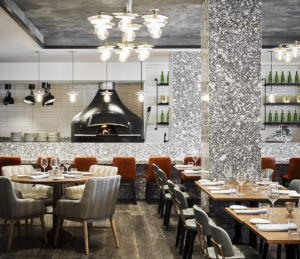A restaurant is an establishment that serves food and drink in exchange for payment. It can be casual or formal, inexpensive or expensive, a standalone establishment, or part of an international chain.
Although the menu items may vary widely, all restaurants serve appetizers and beverages. Some also serve desserts, and some have special theme menus for certain occasions. Visit the Restaurants In Tempe to learn more.

Restaurants are food and drink establishments that offer customers a wide range of cuisines. They vary in price and size, from fast-food chains to high-end restaurants. Some are standalone businesses, while others are attached to hotels, leisure facilities, or other businesses. The definition of a restaurant has changed over time as the industry has evolved, but one thing remains constant: restaurants are intended to provide customers with a pleasant dining experience.
The earliest restaurant types were simple lunching or dining places that served modest food in simple settings. Then, industrialization caused social changes that led to the development of more formal dining establishments. The modern restaurant has many forms and can be found everywhere from the corner diner to the five-star fine dining restaurant.
Some restaurant types are specialized, serving food from a particular region or culture. These include French, Japanese, Chinese and Indian restaurants. Other types are based on a specific cuisine, such as Mexican or Italian restaurants. Restaurants may also be categorized by their style of service, such as buffets or smorgasbord restaurants.
Appetizers, soups and salads are usually served prior to the main meal in most restaurant types. They can be served as separate courses or as part of a combo meal. Most restaurants then offer a selection of entrees, and some even have a dedicated vegetarian or vegan menu. Desserts are commonly offered as the final course in a restaurant meal.
Types
Understanding the different types of restaurants is important for consumers as it can help them make informed dining decisions. From fast food favorites to upscale fine-dining establishments, there is a restaurant type for every taste and occasion. Understanding the different categories can also help restaurant owners identify and cater to their desired clientele.
In general, a restaurant can be broadly classified by its level of formality, service style, and menu type. The level of formality is based on how the establishment is expected to be staffed and presented, as well as the overall dining experience. For example, a fine dining restaurant is usually more formal than a diner or family-style restaurant. Service styles can range from full service, where staff attend to guests’ needs throughout their visit, to limited or self-service, such as at a fast food restaurant or drive-thru window.
The menu type refers to the types of foods available and can include traditional, contemporary, or fusion dishes. Some restaurants are categorized by their specialty, such as seafood or steakhouses. Others are specialized by cuisine, such as Italian or Mexican. Other restaurant types include vegetarian and vegan establishments that serve plant-based meals.
Many people find themselves drawn to particular restaurant types, depending on their personal preferences and tastes. For example, some may prefer to eat at a diner that offers comforting, home-style food, while other people enjoy the convenience and variety of fast casual eateries. Those with more adventurous palates might choose to try new types of restaurants, which can provide a unique and delicious culinary experience.
Some restaurants are characterized by the ambiance and theme that they create to deliver an immersive and entertaining dining experience. These include themed restaurants, such as those with a rainforest or movie franchise theme, as well as pop-up and ghost restaurants that offer a short-term dining experience. Understanding the different types of restaurants can be useful for restaurant critics and reviewers who must consider the specific context and expectations of their audience when evaluating an establishment. This allows them to give an accurate and fair evaluation of the restaurant’s performance in meeting its intended goals.
Menus
Whether your restaurant serves fine-dining fare or fast-food, it is important to have a menu that tells the story of your brand and entices diners. A well-designed menu can enhance the ambiance of your dining room and even influence customer spending habits.
In addition to the dishes available at your restaurant, a menu should include pricing information and an option for guests with dietary restrictions. It is also a good idea to add nutritional values to your menu items so customers can be more informed when choosing their meals.
The best way to create a restaurant menu is to start with a list of your dishes and then decide how to organize them into categories. For example, some restaurants choose to group dishes into appetizers, entrees and desserts. Others organize their menu by color or ingredient. While the number of items on a menu may seem daunting, creating a menu that is logically organized will make it easier for customers to find what they are looking for.
A restaurant’s menu should contain all of its current offerings, with the exception of those that are seasonal or unavailable due to unforeseen circumstances. Generally, a menu will include appetizers, entrees and desserts, as well as beverages. In some cases, the menu will include side dishes and specials. Some restaurants are also adding a vegetarian and gluten-free section to their menus.
In order to increase profits, savvy restaurateurs utilize a technique known as “menu engineering.” This involves placing the most profitable dishes at the beginning and end of the menu to draw in customers. Moreover, restaurateurs use a design technique called “framing” to direct diners’ attention to certain items on the menu. This includes using a different color for call-out boxes, different fonts for sections and icons for categories of dishes.
Another menu design trick is to keep the background of a menu simple so that it doesn’t distract from the food. In general, it is a good idea to avoid high contrast and saturated colors. You also want to ensure that the text on your menu is easy to read. This is why it is a good idea to use a variety of fonts and sizes, as well as to incorporate some white space.
Staff
A restaurant requires a well-oiled team of employees to run smoothly. From a dishwasher to a head chef, each member of the staff plays an essential role that impacts the entire operation. Mistakes, misunderstandings or even a single bad attitude can have a domino effect on the rest of the staff and customers. With this in mind, managers must be sure to select the best candidates during the hiring process and do their best to keep turnover low.
In addition to hiring the right people, it’s also important for restaurants to promote job satisfaction and foster good communication between their staff members. This can be done by offering opportunities for promotion (such as working up to a waitress position) and providing ongoing training to improve employee performance. It’s also helpful for restaurants to have a system in place that lets employees communicate with each other about scheduling issues, shift changes and more.
The restaurant industry is known for being highly competitive, but it’s not uncommon for employees who put in the effort to become great servers or bartenders to stay with their employer for a long time. This is why it’s important for managers to make sure they are showing their appreciation and giving recognition to their top performers.
Some of the most important positions in a restaurant are the servers or waitstaff, who are responsible for taking guests’ orders and attending to their tables throughout their dining experience. They are the face of the restaurant and should be friendly and attentive to all customers. Other restaurant positions include the host (or maitre’d), who manages dining reservations and welcomes guests upon arrival. Bartenders, who prepare and serve alcoholic drinks such as wine and beer, are another specialized restaurant position.
Other restaurant positions that are less common but still necessary to have at a restaurant include a manager, assistant manager and kitchen crew. It’s also important for a restaurant to have a janitorial staff, which is responsible for cleaning the restaurant at the end of each day. Having a dedicated staff of experienced managers and trained janitors can help ensure that the restaurant operates in an efficient and professional manner at all times.
